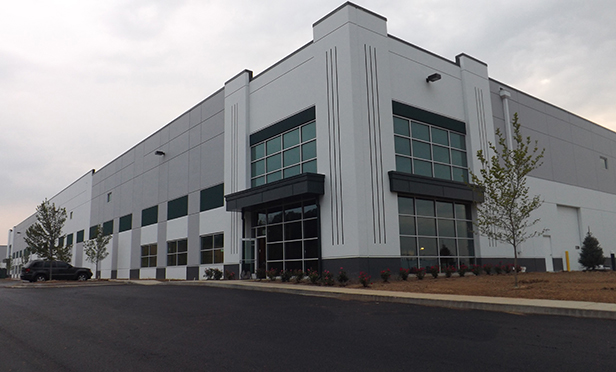 This is an HTML version of an article that ran in Real Estate Forum. To see the story in its original format, click here.
This is an HTML version of an article that ran in Real Estate Forum. To see the story in its original format, click here.  “We recently completed the lease-up of Gateway Industrial III, a 220,000-square-foot spec distribution center in Plainfield, IN, immediately southwest of the Indianapolis International Airport,” says Bob Smietana, HSA Commercial's vice chairman and CEO. “Our pipeline projects include a smaller 150,000-square-foot spec warehouse that will be built adjacent to Gateway Industrial III, the fifth and final building our firm plans to develop in the Gateway Business Park.” The firm also has developments planned this year in both Nashville and southeast Wisconsin.
“We recently completed the lease-up of Gateway Industrial III, a 220,000-square-foot spec distribution center in Plainfield, IN, immediately southwest of the Indianapolis International Airport,” says Bob Smietana, HSA Commercial's vice chairman and CEO. “Our pipeline projects include a smaller 150,000-square-foot spec warehouse that will be built adjacent to Gateway Industrial III, the fifth and final building our firm plans to develop in the Gateway Business Park.” The firm also has developments planned this year in both Nashville and southeast Wisconsin.  As the RCA report revealed, secondary and tertiary markets have become especially attractive to multifamily investors due to their relative yields. With rising rents and occupancies pushing up values in core markets, Martin has seen a greater number and variety of investors—including those that did not previously have a presence in secondary and tertiary markets—seek out higher returns in these cities, leading to heightened competition.
As the RCA report revealed, secondary and tertiary markets have become especially attractive to multifamily investors due to their relative yields. With rising rents and occupancies pushing up values in core markets, Martin has seen a greater number and variety of investors—including those that did not previously have a presence in secondary and tertiary markets—seek out higher returns in these cities, leading to heightened competition.  “That makes them more susceptible to incremental competition,” Martin says. “And because they tend to be less dense than core markets, secondary and tertiary markets sometimes offer a greater variety of housing options, including single-family homes, condos and townhomes that could pose a threat to apartment demand over the long term.” What's more, he says, the economies of these smaller cities can be less diversified, with fewer industries or higher-paying jobs than what you might see in a primary market. The result: institutional investor interest is sometimes lower due to the inherent risks associated with these markets. For some players, the higher returns offered by a particular market simply aren't enough to offset the potential challenges.
“That makes them more susceptible to incremental competition,” Martin says. “And because they tend to be less dense than core markets, secondary and tertiary markets sometimes offer a greater variety of housing options, including single-family homes, condos and townhomes that could pose a threat to apartment demand over the long term.” What's more, he says, the economies of these smaller cities can be less diversified, with fewer industries or higher-paying jobs than what you might see in a primary market. The result: institutional investor interest is sometimes lower due to the inherent risks associated with these markets. For some players, the higher returns offered by a particular market simply aren't enough to offset the potential challenges.  Despite the migration to secondary markets, heavy hitters are not turning their backs on the long-term promise of the core. According to LaSalle Investment Management, high quality, stabilized, long-leased assets are less sensitive than higher risk strategies to market volatility. With high occupancy and a small share of leases rolling over each year, the firm reports, income is more stable and liquidity is likely to hold up better in top tier locations.
Despite the migration to secondary markets, heavy hitters are not turning their backs on the long-term promise of the core. According to LaSalle Investment Management, high quality, stabilized, long-leased assets are less sensitive than higher risk strategies to market volatility. With high occupancy and a small share of leases rolling over each year, the firm reports, income is more stable and liquidity is likely to hold up better in top tier locations.  This is an HTML version of an article that ran in Real Estate Forum. To see the story in its original format, click here.
This is an HTML version of an article that ran in Real Estate Forum. To see the story in its original format, click here.  “We recently completed the lease-up of Gateway Industrial III, a 220,000-square-foot spec distribution center in Plainfield, IN, immediately southwest of the Indianapolis International Airport,” says Bob Smietana, HSA Commercial's vice chairman and CEO. “Our pipeline projects include a smaller 150,000-square-foot spec warehouse that will be built adjacent to Gateway Industrial III, the fifth and final building our firm plans to develop in the Gateway Business Park.” The firm also has developments planned this year in both Nashville and southeast Wisconsin.
“We recently completed the lease-up of Gateway Industrial III, a 220,000-square-foot spec distribution center in Plainfield, IN, immediately southwest of the Indianapolis International Airport,” says Bob Smietana, HSA Commercial's vice chairman and CEO. “Our pipeline projects include a smaller 150,000-square-foot spec warehouse that will be built adjacent to Gateway Industrial III, the fifth and final building our firm plans to develop in the Gateway Business Park.” The firm also has developments planned this year in both Nashville and southeast Wisconsin.  As the RCA report revealed, secondary and tertiary markets have become especially attractive to multifamily investors due to their relative yields. With rising rents and occupancies pushing up values in core markets, Martin has seen a greater number and variety of investors—including those that did not previously have a presence in secondary and tertiary markets—seek out higher returns in these cities, leading to heightened competition.
As the RCA report revealed, secondary and tertiary markets have become especially attractive to multifamily investors due to their relative yields. With rising rents and occupancies pushing up values in core markets, Martin has seen a greater number and variety of investors—including those that did not previously have a presence in secondary and tertiary markets—seek out higher returns in these cities, leading to heightened competition.  “That makes them more susceptible to incremental competition,” Martin says. “And because they tend to be less dense than core markets, secondary and tertiary markets sometimes offer a greater variety of housing options, including single-family homes, condos and townhomes that could pose a threat to apartment demand over the long term.” What's more, he says, the economies of these smaller cities can be less diversified, with fewer industries or higher-paying jobs than what you might see in a primary market. The result: institutional investor interest is sometimes lower due to the inherent risks associated with these markets. For some players, the higher returns offered by a particular market simply aren't enough to offset the potential challenges.
“That makes them more susceptible to incremental competition,” Martin says. “And because they tend to be less dense than core markets, secondary and tertiary markets sometimes offer a greater variety of housing options, including single-family homes, condos and townhomes that could pose a threat to apartment demand over the long term.” What's more, he says, the economies of these smaller cities can be less diversified, with fewer industries or higher-paying jobs than what you might see in a primary market. The result: institutional investor interest is sometimes lower due to the inherent risks associated with these markets. For some players, the higher returns offered by a particular market simply aren't enough to offset the potential challenges.  Despite the migration to secondary markets, heavy hitters are not turning their backs on the long-term promise of the core. According to LaSalle Investment Management, high quality, stabilized, long-leased assets are less sensitive than higher risk strategies to market volatility. With high occupancy and a small share of leases rolling over each year, the firm reports, income is more stable and liquidity is likely to hold up better in top tier locations.
Despite the migration to secondary markets, heavy hitters are not turning their backs on the long-term promise of the core. According to LaSalle Investment Management, high quality, stabilized, long-leased assets are less sensitive than higher risk strategies to market volatility. With high occupancy and a small share of leases rolling over each year, the firm reports, income is more stable and liquidity is likely to hold up better in top tier locations.© 2025 ALM Global, LLC, All Rights Reserved. Request academic re-use from www.copyright.com. All other uses, submit a request to [email protected]. For more information visit Asset & Logo Licensing.







